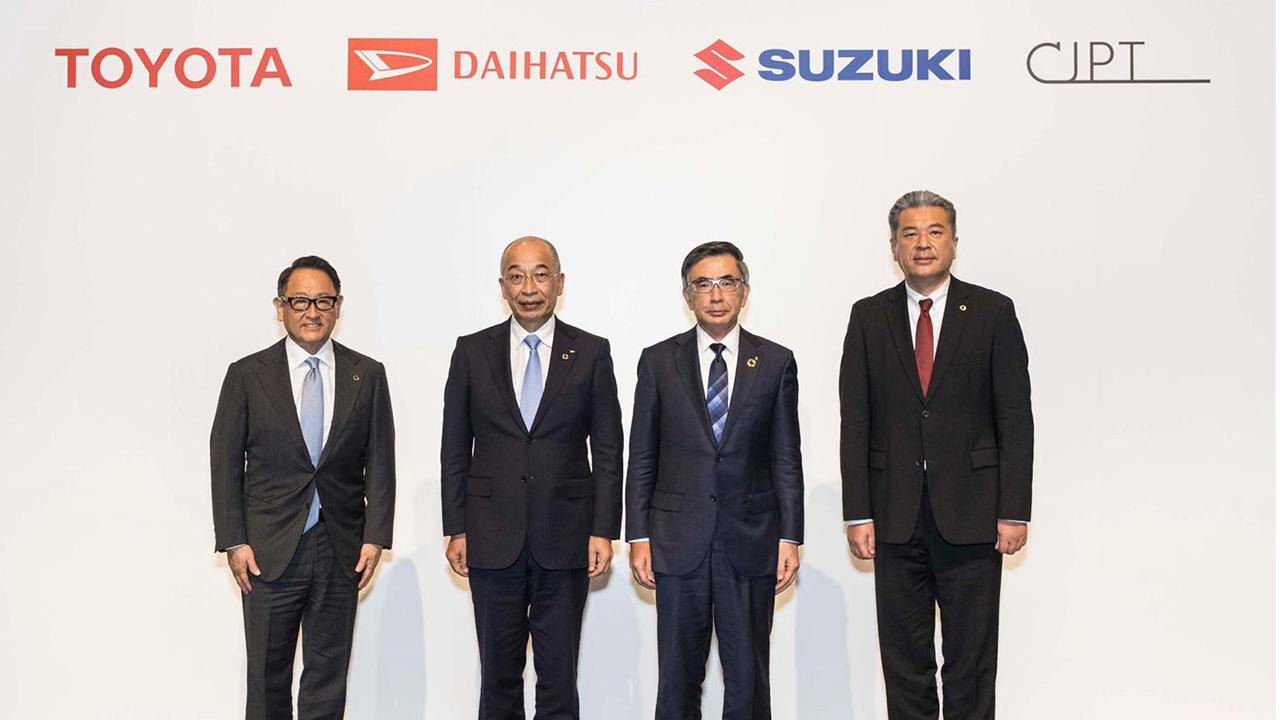
In announcing the participation of minivehicle manufacturers Suzuki and Daihatsu in a Toyota-initiated commercial vehicle business partnership, the three companies' presidents shared their expectations for synergy through new collaboration.

In March this year, Isuzu Motors Limited, Hino Motors, Ltd., and Toyota Motor Corporation launched the Commercial Japan Partnership (CJP), a project to promote CASE in the commercial vehicle business. The project aims to overcome various difficulties facing the transportation industry and to realize a carbon-neutral society.
It has now been announced that Suzuki and Daihatsu will join the project. Why have those two minivehicle manufacturers decided to do so? And what kind of synergies will come forth? This story examines their true intentions through the comments and responses to questions by the heads of Suzuki, Daihatsu, and Toyota during the press conference explaining this development.
Toyota President Akio Toyoda: Minivehicles are “the people’s car” and a lifeline
The first to speak at the press conference was Akio, who had approached Suzuki and Daihatsu to join the project. He shared his thoughts on minivehicles and the two companies.
Akio
“We want to help improve people’s lives.”
“We want to help leave a better Japan and a better planet for the next generation.”
This is the mission of the automotive industry and the origin of the founding of the three companies present here today.
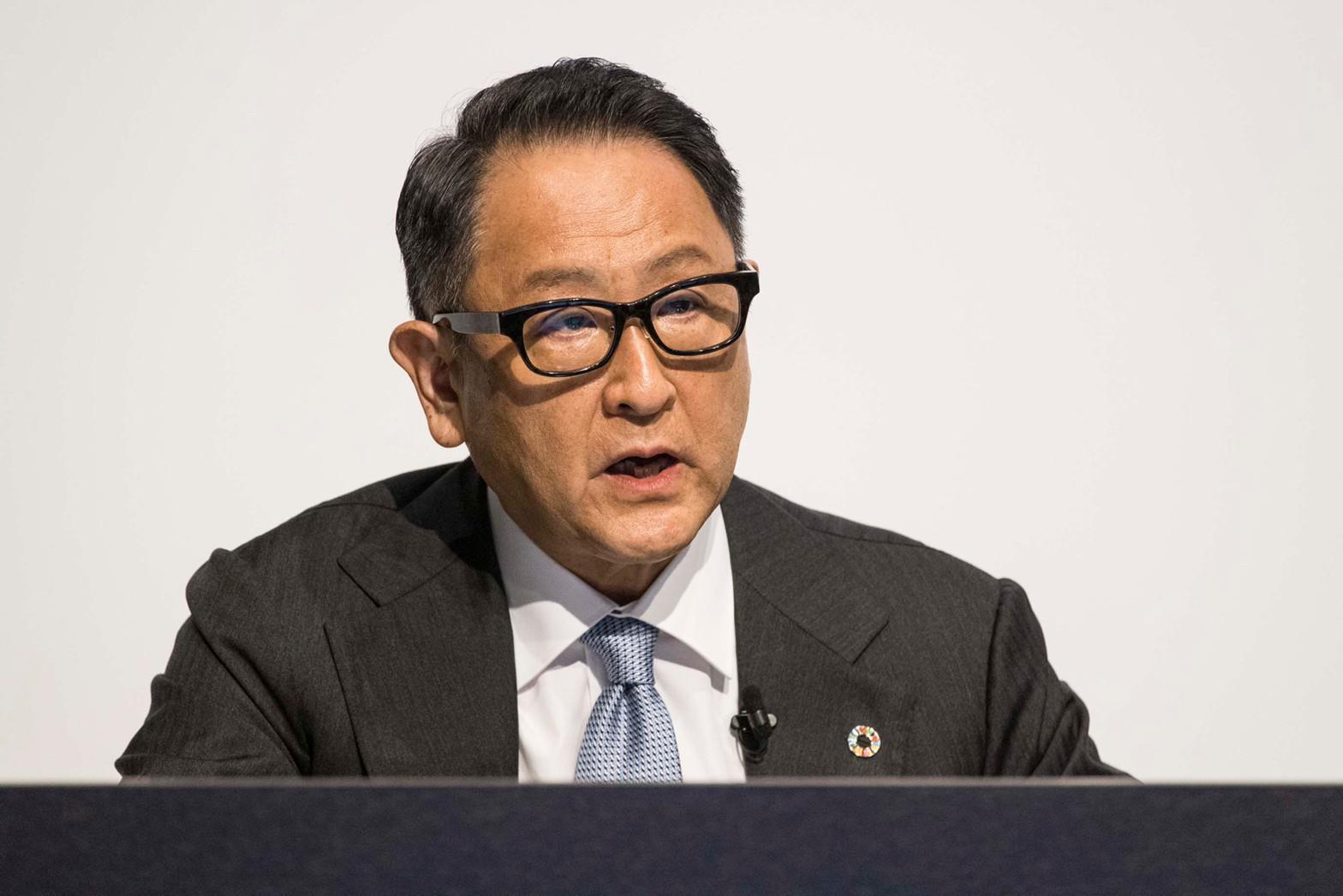
The commercial business partnership announced in March by Isuzu, Hino, and Toyota was prompted by the same idea. Initiatives are now underway for easing the work situations of troubled colleagues on the front lines of transportation and for protecting the prosperous lifestyles that transportation supports.
With Suzuki and Daihatsu now joining us in this project, we will take on the challenge of improving the lives of people supported by minivehicles.
Of the 78 million cars owned in Japan, 31 million are minivehicles. In many rural areas, minivehicles account for more than 50 percent of owned vehicles.
In Japan, 85 percent of roads are so narrow that they can only be used smoothly by minivehicles.
Roads make cars. Minivehicles are collectively the “people’s car” made by the roads of Japan. And they are a practical and sustainable lifeline of Japan that has continued to evolve along with people’s lives.
However, great challenges now lay ahead of us. The CASE revolution and the necessity to achieve carbon neutrality are now forcing the world of minivehicles to undergo a profound transformation.
I believe that no matter how much the times change, we must not abandon either minivehicles or our customers.
For more than 60 years, Suzuki and Daihatsu have been protecting this lifeline and driving forward the market.
They continue to produce not only passenger cars but also commercial vehicles that support a variety of jobs such as those in agriculture and delivery.
Although mini-commercial vehicles present extreme challenges when thinking only in terms of profitability, they are indispensable to Japan.
That is what has driven these two companies to make effort, come up with new ideas, and keep going. In other words, what they have been true to are the mission of the automotive industry and a user’s perspective that puts customers first.
By working together, these two companies will be able to know the reality of nearly 70 percent of Japan’s minivehicle users.
Nothing could make Toyota happier than to be able to apply its CASE technologies to further evolve minivehicles and help improve people’s lives.
Moving forward, it is essential to think about vehicles as a set with infrastructure. Leadership in both the government and the private sector is now needed more than ever. Furthermore, achieving carbon neutrality is a challenge that can only be solved if all people and all industries work together.
Following the announcement of the partnership among Isuzu, Hino, and Toyota in March, many people, including local governments, infrastructure companies, and transportation companies, have told us that they would like to work together.
With Suzuki’s and Daihatsu’s joining this project and our working together, we will be able to expand our circle of cooperation to not only cover commercial vehicles but also minivehicles. With this expansion, I believe that we will be able to take one step closer to a better mobility society in which many people can be happier.
With a strong will and passion, and going beyond where we each normally belong, we are committed to taking action for Japan and the Earth. I would like to ask for your understanding and support.
Suzuki President Toshihiro Suzuki: I want to pass to the future the baton of “works of art”
Next up was President Suzuki, who explained the mission of minivehicle manufacturers and what led to participation in CJP.
President Suzuki
While watching the Toyota, Hino, and Isuzu press briefing to announce the CJP project in March this year, I realized that we could enrich society even more by not only connecting the distribution bases of large trucks but also connecting those distribution bases to customers’ homes.
Speaking at a meeting of Suzuki’s sales bases in early April, I shared my thoughts that, to achieve this, mini-commercial vehicles, which account for 58 percent of all commercial vehicles, also need to participate in the project, and, by doing so, we could contribute more to the world.
Since minivehicle standards were established in 1949, minivehicles have been used for a variety of purposes, such as in local transportation, in agriculture, forestry & fisheries, as well as in construction, retail, and logistics, to enrich people’s lives by being close to them, including in their work.
In Japan, every industry is now endeavoring to achieve carbon neutrality, and the world of minivehicles is no exception.
Our mission is to bring to market minivehicles that are affordable and contribute to carbon neutrality and to continue to be an indispensable part of our customers’ lives. However, accomplishing this mission on our own would be very difficult. The whole of society must work toward the same goal to achieve it.
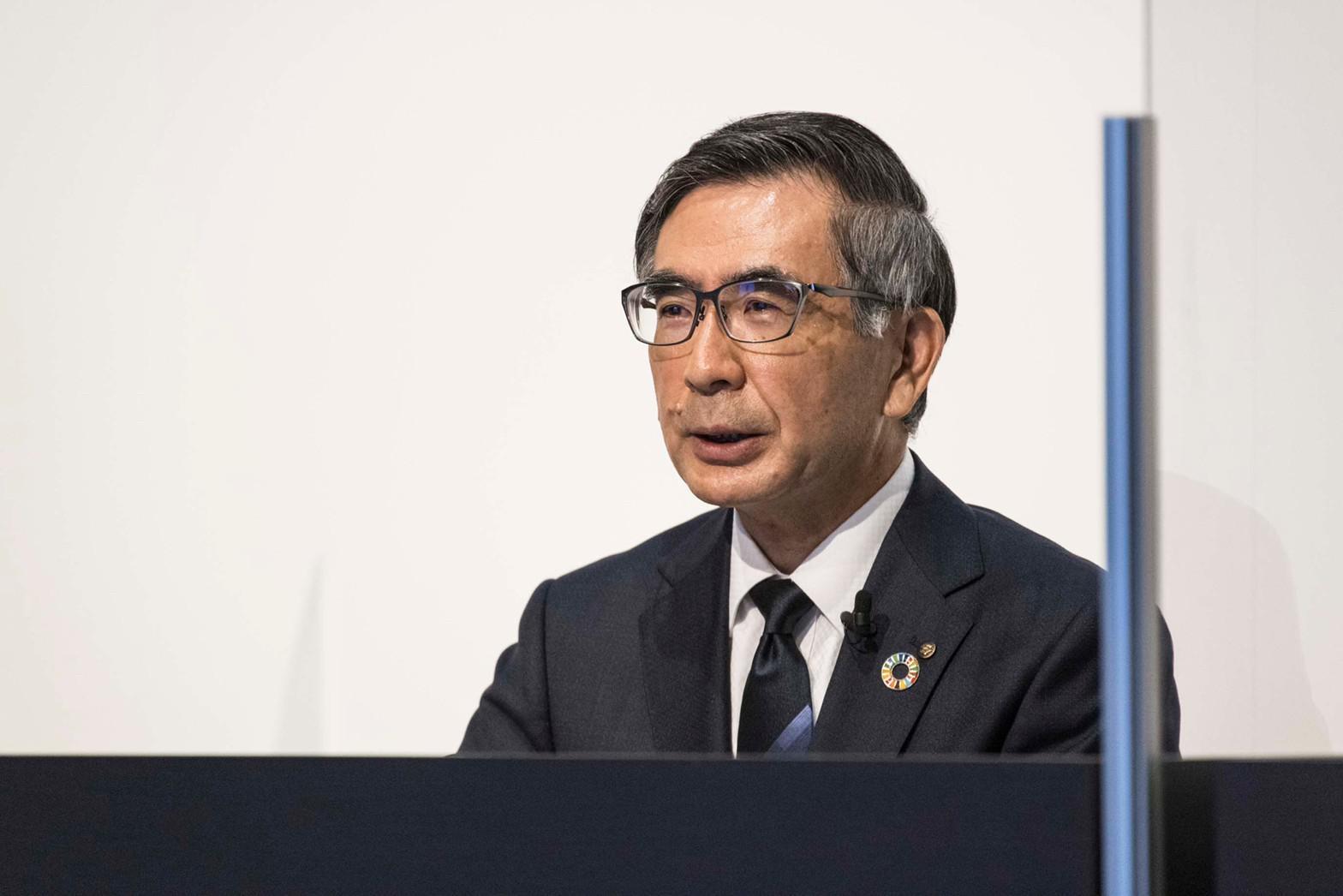
Daihatsu felt the same way, and we had been discussing what we could do together. During such, Toyota approached us and invited us to work together to maintain Japan’s lifelines. Because the philosophy and purpose of CJP resonated with us, we decided to join the project.
When Toyota proposed that Daihatsu and Suzuki join CJP, I was very happy to learn that President Toyoda was thinking the same as I was.
Our company’s senior advisor, Osamu Suzuki, described minivehicles as “works of art” created under various restrictions such as those related to size, engine displacement, and above all, an affordable price.
We want to evolve minivehicles, which are collectively the “people’s car” and lifeline, in stride with the changing times and to pass on to the future the baton of the “works of art” created by our predecessors as tools to enrich the lives of our customers. That is our mission and hope.
As like-minded colleagues, we would like to start by working together as five companies.
Daihatsu President Soichiro Okudaira: Integration from the “main arteries” to the “capillaries”
Carrying forward the baton from President Suzuki, Daihatsu President Soichiro Okudaira began to speak. He talked about the important role of minivehicles in achieving carbon neutrality and responding to CASE, as well as about the specific details of the announced collaboration.
President Okudaira
As President Toyoda mentioned, there are 31 million minivehicles under ownership in Japan, which is about 40 percent of all owned vehicles in the market, with 8 million of them being mini-commercial vehicles.
The number of in-use minivehicles is steadily increasing, and there is a strong demand for mini-commercial vehicles not only among fleet customers but also among individual customers.
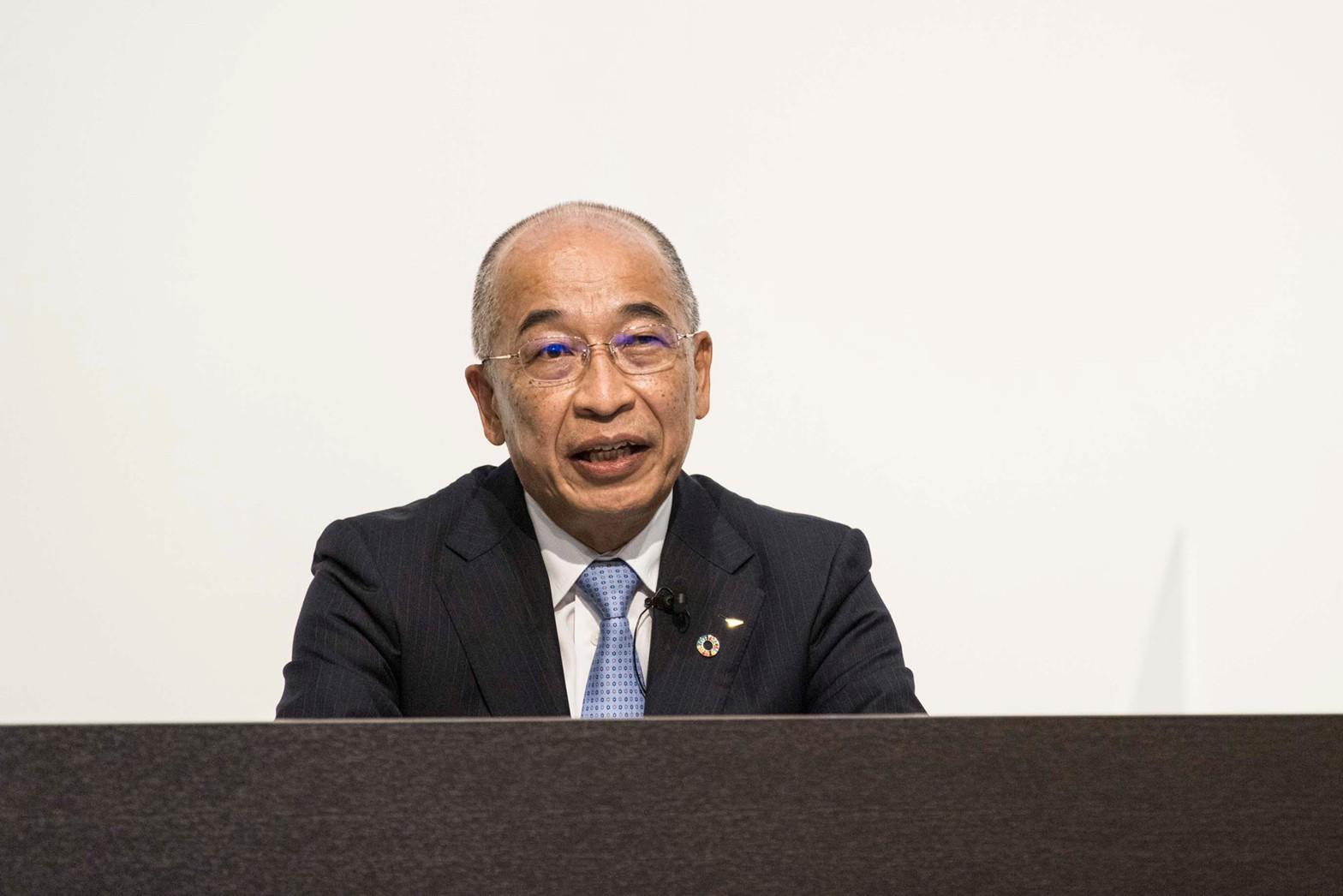
With such a large number of customers using minivehicles, we minivehicle manufacturers believe that it is our responsibility to make people’s lives safer, more secure, and more prosperous by promoting carbon neutrality and by achieving the dissemination of CASE technologies and services for minivehicles.
Meanwhile, we have been offering customers affordable fuel-efficient technologies and advanced safety technologies by thoroughly pursuing low-cost manufacturing by way of simple factories, simple design elements, and slim fixed costs.
Also, our internal research shows that the current CO2 emissions of minivehicles from a life cycle assessment perspective are about 30 percent lower than non-minivehicle compact cars and comparable to those of small hybrid electric vehicles.
Our understanding is that it is no easy task to disseminate CASE technologies and services and to reduce CO2 emissions beyond the current level while keeping prices affordable. We have truly entered a once-in-a-century era of profound transformation.
It is extremely difficult to independently address these issues, and that necessitates a collaborative effort that goes beyond conventional frameworks.
Therefore, President Suzuki and I had been discussing for some time whether there were areas in which we could work together for the sake of our customers. We were then approached by President Toyoda, leading to what we are announcing today.
I am convinced that adding Toyota’s CASE technologies to Isuzu and Hino, which are commercial vehicle professionals, and that participation in this project by Suzuki and Daihatsu, which have dedicated themselves to minivehicles, will create significant synergies.
These include an integrated commercial vehicle infrastructure that covers, figuratively speaking, “from the main arteries to the capillaries”, as well as the realization of electrification suitable for minivehicles through the fusion of advanced technologies and low-cost manufacturing.
I would like to explain the specific details of our participation in this partnership, including what we will consider going forward.
The first point is related to connected technologies.
Japan has about 60,000 logistics companies, roughly 70 percent of which are small-scale companies with fewer than 20 employees or one-person operations, and there is still a long way to go for automakers to meet the needs of individual customers.
Through this partnership, we would like to seek frontline customer feedback that has thus far escaped us. And we would like to build an infrastructure that connects various elements, including data, of trucks to mini-commercial vehicles, which are responsible for the last mile, to improve the efficiency of logistics as a whole.
The second point has to do with advanced safety technology, such as advanced driver-assistance systems that protect our customers.
We will bring together the technologies and know-how of each company and study the development of advanced safety technologies that are more affordable with a view toward future development.
The third point concerns the electrification of minivehicles, including mini-commercial vehicles.
Toward achieving carbon neutrality, we will take on the challenge of developing affordable electrified minivehicles through technological cooperation on electric components and by consolidating development resources.
By collaborating on the three points, we will aim to include minivehicles in the societal implementation of CASE technologies and services. We, too, will put into practice President Toyoda’s “Give it a try” thinking.
As of today, Suzuki and Daihatsu are now members of the Commercial Japan Partnership, a commercial vehicle project by Isuzu, Hino, and Toyota, and we will begin our efforts with commercial vehicles as the starting point. To promote collaboration, Suzuki and Daihatsu will each acquire 10 percent of Commercial Japan Partnership Technologies, which is the joint venture for the project, through a share transfer.
As a manufacturer of minivehicles, Daihatsu will continue to provide products and services while insisting on products that are compact, light, and low-cost so that minivehicles, which serve as a lifeline, will remain affordable and accessible to our customers.
Through this partnership, we will accelerate such efforts.
The merits of adding minivehicles
After the three presidents spoke, a question and answer session was held. The questions that came up were about the role of minivehicles in this collaboration and the benefits to be gained from this collaboration.
President Suzuki
Minivehicles account for 58 percent of commercial vehicles, and I believe that the last mile of large-scale logistics and small-lot delivery can be integrated through connected technologies.
Until now, the two have been connected as “blood vessels”, so to speak, but the handover process has been linked by way of paper and the skills of experienced people, not in a single streamlined way.
Using connected technologies, we will be able to use minivehicles as the “capillaries” to improve the efficiency of logistics while understanding the situations of the driver shortage in large-scale logistics and inefficiencies in loading volumes.
I believe that we will be able to create a finer mesh of “capillaries”, improve the flow, and build a logistics system that meets the needs of the era of carbon neutrality.
I think what we need to pursue is to master being a provider of friendly mobility tools for people.
I don't think this is possible to do only with minivehicles. We would like to evolve vehicles that serve as friendly mobility tools and works of art, by considering various things such as how we can make them go when reducing the size of batteries, while promoting the development of infrastructure, including charging points.
Based on Suzuki’s long-time concept of “small, less, light, short, and beautiful”, I would like to firmly master the making of vehicles that serve people as friendly mobility tools while involving suppliers and users as well.
Daihatsu President Okudaira talked about the expected effects on ease of work on the front lines of logistics.
President Okudaira
First of all, we want to connect in an integrated way the “main arteries” and “capillaries” of logistics, from truck logistics to mini-commercial vehicle small-lot delivery. This means that we want to work together on a connected infrastructure.
We announced in the spring of this year the joint development of standardization and specifications for communication equipment systems. While adding such things, we would like to conduct implementation and verification in the CJP project.
Although trucks as “main arteries” are coming to be connected, that is not yet the case for mini-commercial vehicles, most of which rely on customers’ smartphones.
With the introduction of CASE technologies, I believe there is great merit in the ability to share data with all concerned, allowing us to provide better services to our customers.
I am also looking forward to being able to eliminate waste and provide a better working environment for drivers by improving the efficiency of logistics.
President Hiroki Nakajima of Commercial Japan Partnership Technologies Corporation, who took the stage with the three automaker presidents and is in charge of executing the project, introduced a specific initiative under consideration.
President Nakajima
In CJP, we have launched a hydrogen utilization project in Fukushima. Working hand in hand with local industries and major convenience store companies and supermarkets, we are advancing a project for the creation of a “primary unit of a city that utilizes hydrogen”, which includes the utilization in delivery of clean hydrogen produced in Fukushima.
We are now considering a project in large cities like Tokyo, in which we utilize small trucks for delivery in truck-based trunk line logistics and delivery to warehouses, as well as utilize connected technology to connect producers to consumers and “main arteries” to “capillaries”.
We believe that if just-in-time logistics becomes possible, it will change the form of warehouses.
I believe that if the five partner companies can unite their strengths to improve logistics in a way that ties it in closer to our daily lives, and if vendors can enjoy the benefits of lower running costs, it will lead to improvements in sustainable logistics.
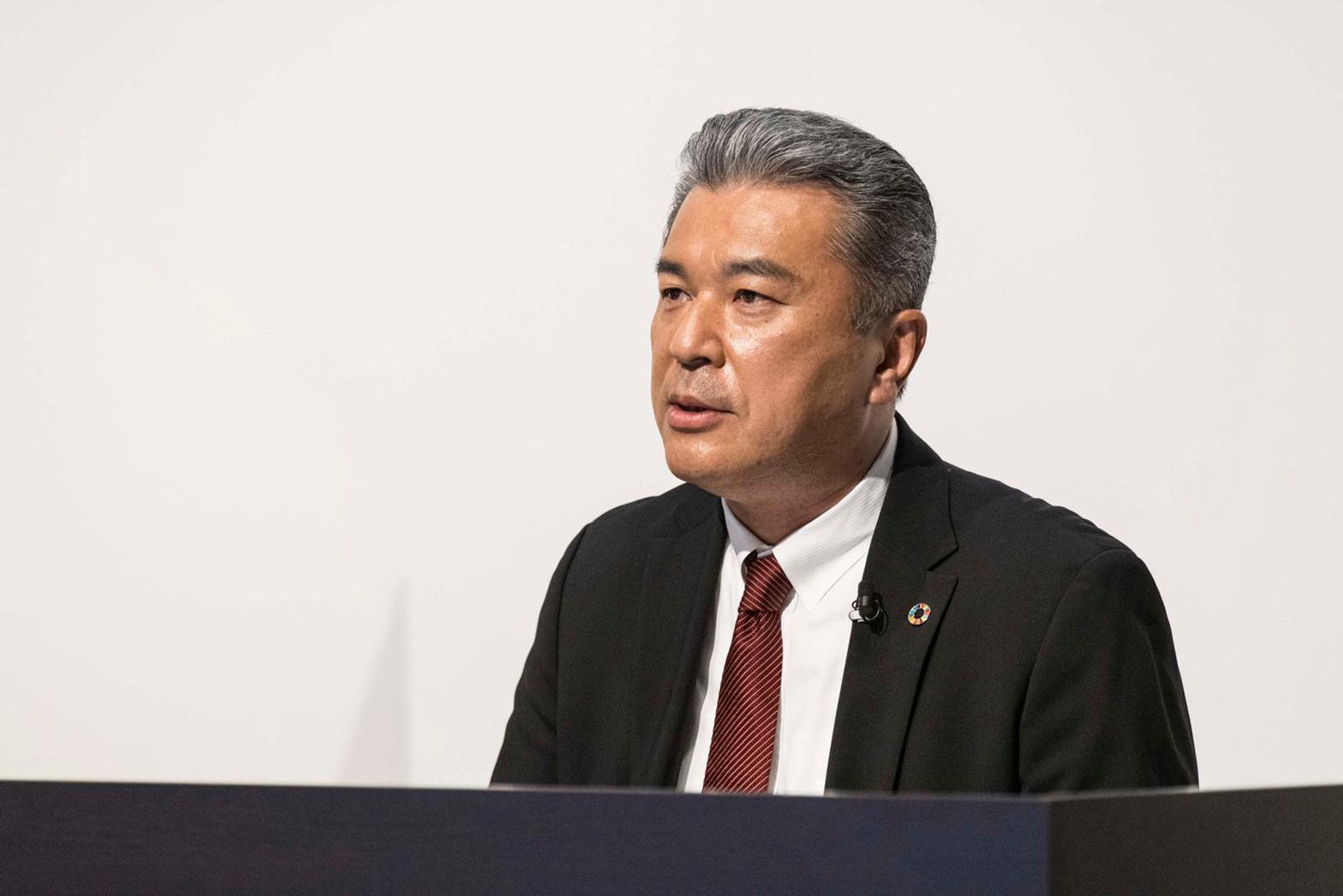
Up to that point, comments had centered on the merits for those working in logistics, such as improved logistics efficiency, but Nakajima said there was even more to gain, and he went on to explain the merits that will be experienced by consumers.
President Nakajima
The merit of an integrated system (from large to small commercial vehicles) is that it shortens the total lead time from producers to consumers. Shortened lead times mean that warehouses and other facilities that serve as intermediate inventory will also change.
That means that consumers will more quickly receive what they need and in a more timely manner. And it means that producers will be able to deliver products to customers while they are still fresh. We recognize that connecting trucks and mini-vehicles for the last mile brings many possibilities.
Akio’s aspirations that linked Suzuki and Daihatsu
As mentioned in remarks of both President Suzuki and President Okudaira, Akio had approached the two companies to join the CJP project. During the Q&A, the reporters also asked about his passion for minivehicles.
Akio supplemented his thoughts on minivehicles, which he called “the people’s car” and a “lifeline”, as follows.
Akio
Both Suzuki and Daihatsu have a sense of mission to create what the world needs and (are full of) a user perspective by being close to the lives of their customers. That is the origin of the foundation of both companies and something that I deeply respect.
Not only in Japan but also overseas, such as in India for Suzuki and Malaysia for Daihatsu, they are applying the technologies and experiences they have cultivated in the minivehicle business to create “the people’s car” in each market, which I believe is leading to smiles also on the faces of their customers overseas.
No matter how much times change, I believe that it is the mission of the automobile industry to protect and develop the history and culture of minivehicles, which both companies have worked so hard to maintain.
And then Akio aroused laughter among those on stage after he tossed a question to the reporters. Akio’s question: “Do you know what my favorite minivehicle is?”.
The answer: “A two-seater with a midship engine.” In other words, a minivehicle truck. A minivehicle truck, which (usually) has its engine under the driver’s seat, could be viewed as having a midship layout, just like a racing car or a full-fledged sports car. At the press conference about the company’s participation in the minivehicle commercial vehicle business, the face of car guy Morizo came out from behind the scenes.
All for leading to better lives
Daihatsu President Okudaira said that through the project: “We will solve the problems of our customers from the customer’s point of view”.
President Nakajima of CJPT emphasized the importance of the customer’s perspective by saying: “Of the 5.5 million people in the automotive industry, 2.7 million are involved in transportation work. If we can listen to those people’s problems and solve them, it will lead to achieving a carbon-neutral society faster.”
That is in rhythm with the reason for initiating CJP.
Akio
As was the case with Isuzu and Hino last time, Suzuki and Daihatsu are also rivals as manufacturers. However, for customers, having them collaborate is more useful. That’s why we created CJP.
In the times to come, for achieving carbon neutrality and for other endeavors, it will be more important than ever for everyone to work together. Toyota’s role in such is to be the “glue”.
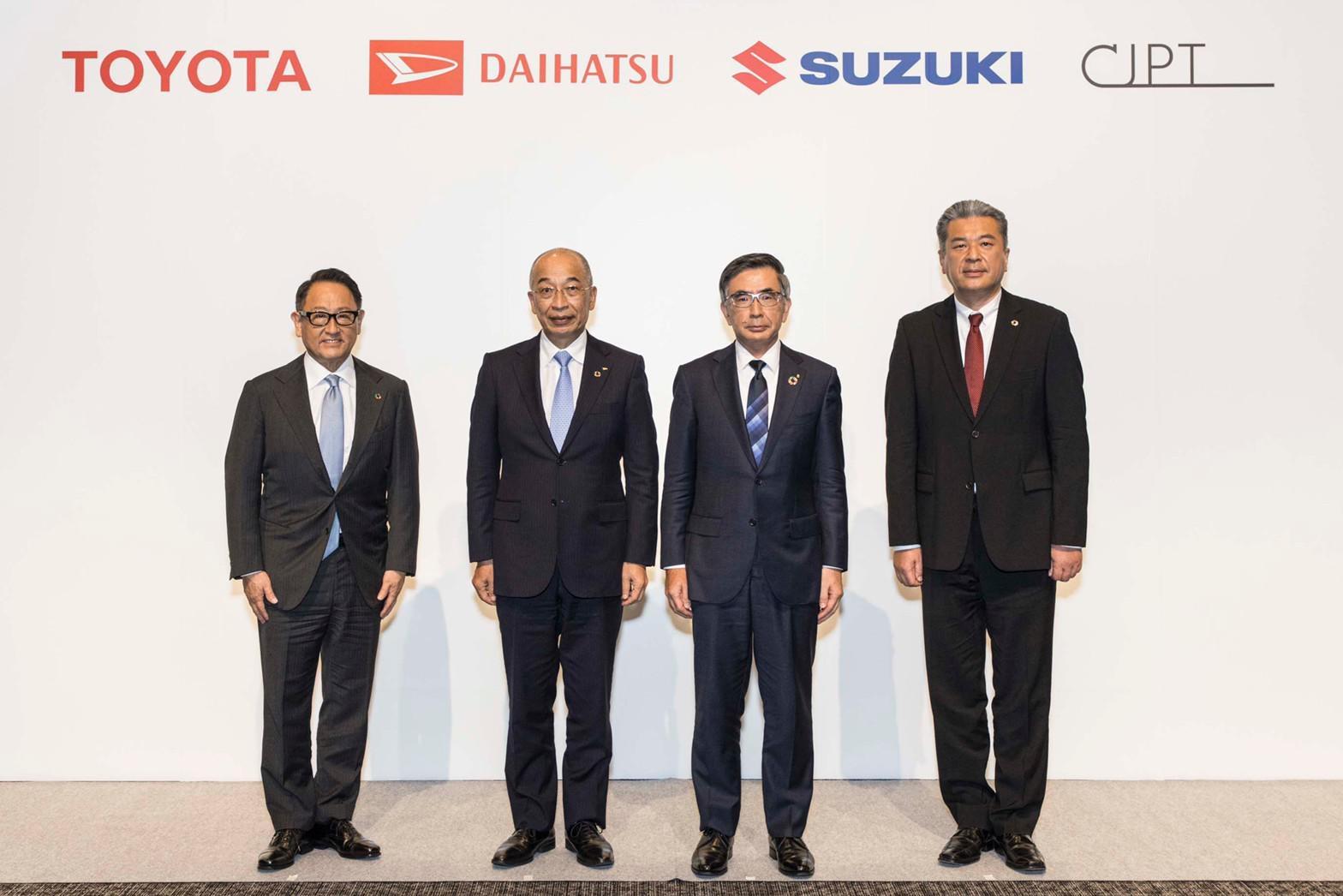
The partnership through this CJP project is expanding with like-minded colleagues. Such an expansion would be to help fulfill the automotive industry’s mission of wanting to help improve people’s lives and wanting to help leave a better Japan and a better planet for the next generation.
At the end of the press conference, Akio presented a message for former Suzuki Chairman Osamu Suzuki, who retired as chairman in June (and is now a senior advisor).

